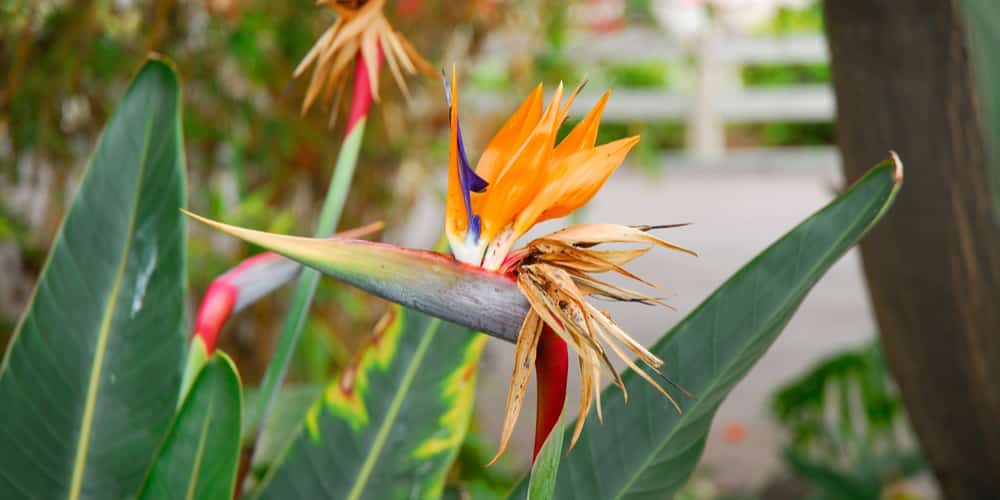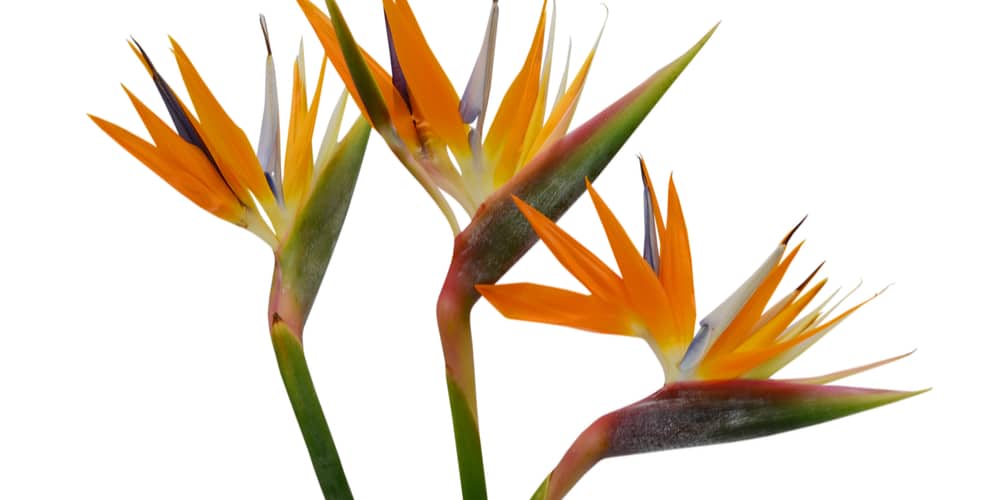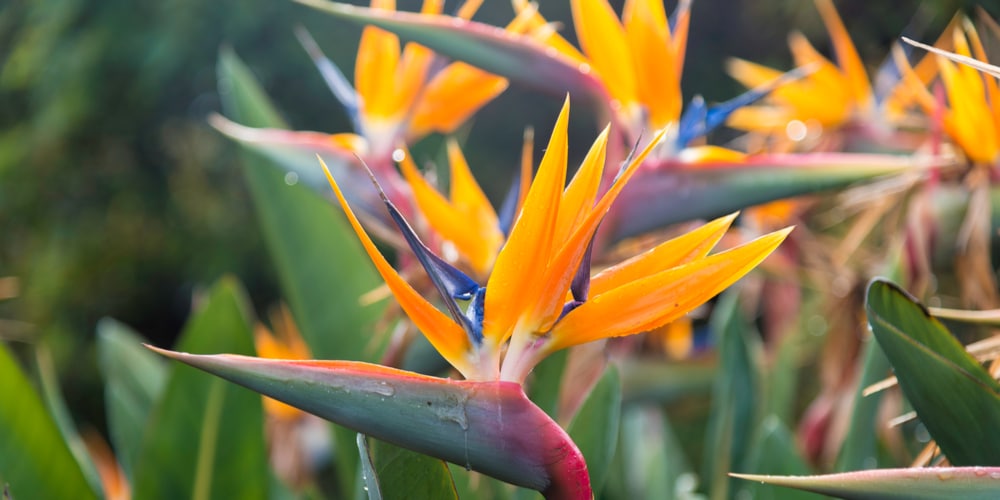Bird of paradise plants have a vibrant and exotic appearance that catches any gardener’s eye. Its leaves can be easily distinguished by their large size and unique shape, glossy texture, and bright green color. As the large leaf paddle unfurls from its sheath, it’s hard not to be mesmerized by this plant.
But what happens when you notice the leaves on your birds of paradise plant start to curl? Is this normal, or should you be worried?
Bird of Paradise Leaves Curling: What Are the Causes?

On average, the bird of paradise stands five feet to thirty feet tall, depending on the variety. Despite the differences, most of these plants have distinct large, deep green leaves that are shaped like an oval and can grow up to two feet long. The leaves’ edges are often toothed or serrated, and the leaf surface is glossy.
It’s normal for new buds to have curly leaves. They’ll eventually unfurl as the plant matures. But if the leaves on your bird of paradise plant are curling and you don’t see any new growth, it could be a sign that something is wrong. Also, if some leaves that were once unfurled are now curling, that’s another cause for concern.
Several reasons why the bird of paradise leaves may start to curl. These may include but are not limited to:
Environmental Stressors
Cultural causes are usually the result of unfavorable growing conditions. This includes some environmental stressors. For instance, if your bird of paradise is not receiving enough sunlight, the leaves may start to curl in an effort to reach out for more light.
Other common environmental stressors include low humidity, high winds, and extreme temperatures (either too hot or too cold). All of these can cause the leaves of your bird of paradise plant to curl.
Temperature shock is a common problem for bird of paradise plants. If you recently moved your plant outdoors, it may be experiencing temperature shock. The leaves will curl as the plant tries to adjust to the new environment.
When orange birds of paradise are grown in pots, they’re especially susceptible to environmental stressors. This is because the roots are confined and have limited access to nutrients and water. As a result, the plant can easily become stressed if the pot doesn’t have proper drainage or if it’s not getting enough light or water.
If you think environmental stressors are to blame for the leaf curl on your bird of paradise plant, there are several things you can do to help it recover. Ensure your plant gets enough sunlight, has the right humidity and is not exposed to extreme temperatures. If possible, move your plant to a more sheltered location.
You can also try misting the leaves with water to increase humidity or using a humidifier near your plant. And make sure you’re watering it regularly, especially during hot weather.
Insect Infestation
Because of their large leaves, it’s easier to see if your bird of paradise plant is infested with insects. Look out for small, raised bumps on the leaf surface as this could be a sign of scale insects. These pests secrete a sticky substance called honeydew that can attract ants and other insects.
Honeydew also promotes the growth of sooty mold, a black fungus that can cover the leaves and stunt the plant’s growth. Not only does this make the plant look unsightly, but it can also affect its ability to photosynthesize. If your plant can’t photosynthesize, it won’t be able to produce the food it needs to grow, causing the leaves to curl.
Nutrient Deficiency
If you come to think about it, if the leaves aren’t getting the nutrients they need, of course, their leaves will start to look less vibrant and less lush, and eventually, they will begin to curl.
A typical nutrient deficiency that affects bird of paradise plants is iron deficiency. This can be caused by several factors, such as poorly draining soil, high pH levels, or excessive rainfall. When the plant doesn’t have enough iron, it can’t produce chlorophyll, which gives leaves their green color. Without chlorophyll, the leaves will start to turn yellow then, brown, and eventually curl.
Other nutrient deficiencies that can cause bird of paradise leaves to curl include nitrogen, phosphorus, and potassium. These are often caused by improper fertilization or soil that’s too acidic or alkaline.
Ensuring that there’s a proper balance of nutrients in the soil is essential to keeping your bird of paradise plant healthy.
Pot-Bound
This commonly happens to indoor plants, including bird of paradise. Oftentimes, we forget to repot our plants, and they stay in the same pot for years. As the plant grows, its roots start to crowd the pot, and this can cause a variety of problems such as stunted growth, leaf drop, and yellowing leaves.
Every few years, it’s essential for plants to get new soil. This is crucial for their growth as it provides them with the necessary nutrients. This means that every time you repot, adding new soil isn’t enough. You also need to add fresh fertilizer to ensure that your plant gets the nutrients it needs.
When a plant is pot-bound, the roots have nowhere to go, and they start to suffocate. This can cause the leaves to curl as the plant tries to get more oxygen. The best way to solve this problem is by repotting your bird of paradise in a pot that’s one size larger.
Overwatering
One of the most common reasons why bird of paradise leaves curl is due to root rot. This is caused by overwatering. This plant is native to tropical climates and doesn’t like too much water. When the roots are constantly wet, they start to rot, and this can cause a variety of problems such as yellowing leaves, leaf drop, and stunted growth.
If you think your plant is overwatered, the first thing you need to do is check the soil. If it’s soggy or mushy, that’s a sure sign that you’re overwatering. The best way to fix this problem is by letting the soil dry out completely before watering again. If you can get rid of the mushy roots, take them out from the soil, and repot your plant in new, dry soil.
It’s also important to make sure that your pot has drainage holes. This will allow the water to drain out of the pot and prevent the roots from sitting in the water.
Underwatering
While overwatering is a common problem, underwatering is just as bad. When bird of paradise plants don’t get enough water, the leaves start to curl as a way to conserve moisture.
If you think your plant isn’t getting enough water, check the soil. If it’s dry or crumbly, that’s a sure sign that you need to water your plant. The best way to solve this problem is by giving your plant a good watering. Make sure to water the soil, not the leaves, and allow the water to soak all the way down to the roots.
If you can’t seem to get your plant to retain moisture, try misting it with water. This will help keep the leaves hydrated and prevent them from curling.

